
Wildfires, often a natural part of many ecosystems, have become an increasing concern due to climate change and human activities. These uncontrolled blazes can devastate vast landscapes, destroying homes, businesses, and natural resources. The impact of wildfires extends far beyond the immediate damage, with long-term consequences for air quality, water resources, and the overall health of the environment.
Understanding the Reasons behind the California Fires
The threat of wildfires in Los Angeles is not new, but climate change has exacerbated it. Rising temperatures and prolonged droughts have increased the frequency and intensity of wildfires in the region. These fires directly threaten life and property and have significant economic and environmental consequences.
Los Angeles, with its Mediterranean climate and sprawling urban development, is particularly vulnerable to wildfires. The combination of hot, dry summers and strong winds creates ideal conditions for fires to ignite and spread rapidly. The city’s unique geography, with its mix of urban areas and wildland-urban interface, further complicates the issue, putting homes and lives at risk.
California’s wildfires result from a complex interplay of climatic, environmental, and geographic factors. Researchers from the University of California, Loa Angels (UCLA) suggest that the “weather whiplash” phenomenon – rapid shifts between extremely wet and dry conditions – may make wildfires more frequent globally. Over the past few years, California has experienced this phenomenon firsthand. After a long period of dry seasons in California, unprecedented rainfall was observed in 2022-2023[1], which spurred the rapid growth of shrubs and grasses; then, the state transitioned to a hot summer followed by an exceptionally dry autumn and winter in 2024. These dry conditions have turned this vegetation into tinder, ready to ignite. Additionally,using wood as a primary material escalated the chances of ignition. It fueled the fire, leading to its excessive spread and more significant damage to the buildings, especially the single-family, single-story houses.
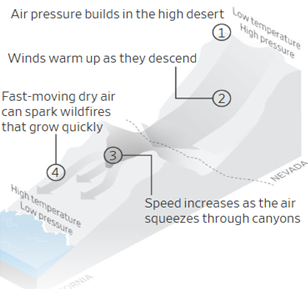
Another key reason for intensifying these fires is the warming atmosphere, which evaporates and absorbs more water with every degree of warming. This depletes moisture from the soil and plants, increases flammability, and contributes to prolonged and severe fire seasons. The Santa Ana winds further exacerbated the situation in Southern California. These strong, dry winds blow in from the deserts of the Great Basin (near Nevada), quickly drying out vegetation and fanning the flames of existing fires, enabling them to spread rapidly.
Role of La Nina
The Climate Prediction Centre (NOAA) announced on January 9, 2024, that La Nina has officially arrived. La Nina phenomena usually divide the state of California into two, bringing mixed results: extensive rain in Northern California and dryer-than-usual weather in Southern California. But this divide is not fixed- it lands in a different spot each time[2].
La Nina is not always bad for California and does not always guarantee dry weather conditions during the winters in South California. Historical data suggests that one out of three times, there have also been cases when the La Nina has been wetter than normal during Southern California in Winters. In this condition, the timing for the La Nina has been unfortunate as the precursors of La Nina have already made dangerous fire conditions in Southern California. While La Niña contributes to drier conditions that elevate wildfire risks in Southern California, it operates alongside other factors such as climate change, the brutal Santa Ana, and regional weather patterns in influencing wildfire activity[3].
History of Wildfires in California
- Historical fire incidence suggests that the highest fire incidence occurred in 2024, followed by 2019 and 2018.
- The Camp Fire of November 2018 tops the list of California’s Top 20 most destructive wildfires.
- Palisades and Eaton make it to 2nd and 4th place in terms of the number of structures damaged (Figure 3)
- Wildfires in 2022 indicate the highest annual acres burnt, while in terms of fire incidence, maximum fire cases were observed in 2024.
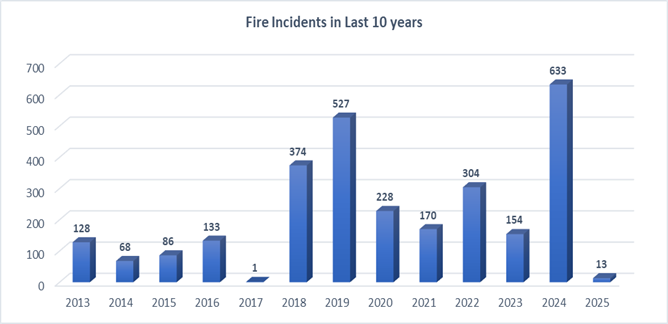
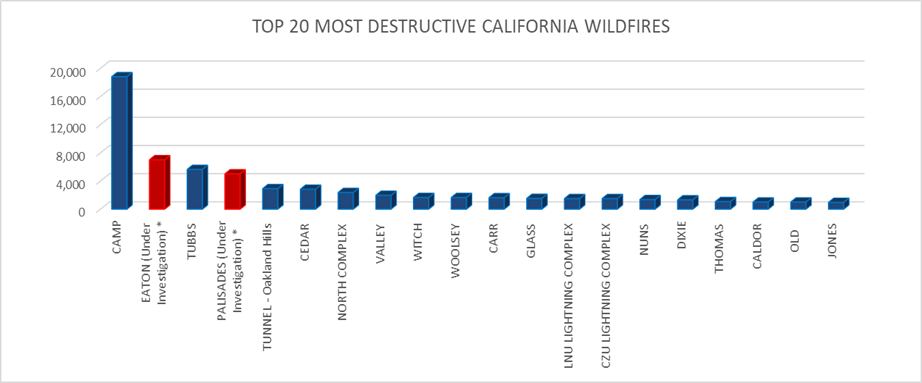
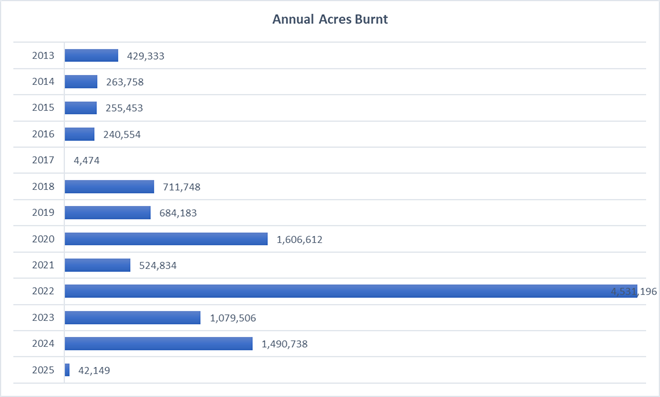
Current Situation of Wildfires in LA
Los Angeles has been fighting a series of catastrophic wildfires that have swept through the region since January 7, 2025. These fires are fuelled by ferocious Santa Ana winds reaching 80-100 mph speed and deepened by prolonged drought conditions. Multiple fires began erupting across Southern California on January 7, 2025, leaving Los Angeles in a devastating situation and prompting mass evacuations. Palisades Fire and Eaton Fire, followed by the Hust Fire, were the initial fires that broke out and left a trail of destruction, claiming lives, displacing thousands, and destroying or damaging numerous structures.
- Lead Meteorologist National Weather Service (NWS) identified three factors fuelling the fires: Strong winds, dry conditions with low humidity, and dry vegetation.
- The fires have burned over 40,687 acres, destroyed 15,800+ structures, and caused at least resulted in 28 fatalities. Around 180,000 residents have been evacuated.
- The Palisades, Eaton, and Hurst fires have burned 38,600 acres in Los Angeles County.
- More than 64,000 homes and businesses were without power across the Ventura, Los Angeles, San Diego, and Riverside counties, as per PowerOutage.us.
- Multiple new fires (Lilac, Clay, Pala, Friars fire) broke out in San Diego County on January 21, 2025, prompting evacuation orders, school closures, and power shutoffs, while officials are on high alert in LA made strong winds and relentlessly dry conditions.
- As per AccuWeather, estimated damages range from $250 billion to $275 billion, reflecting severe economic impact.
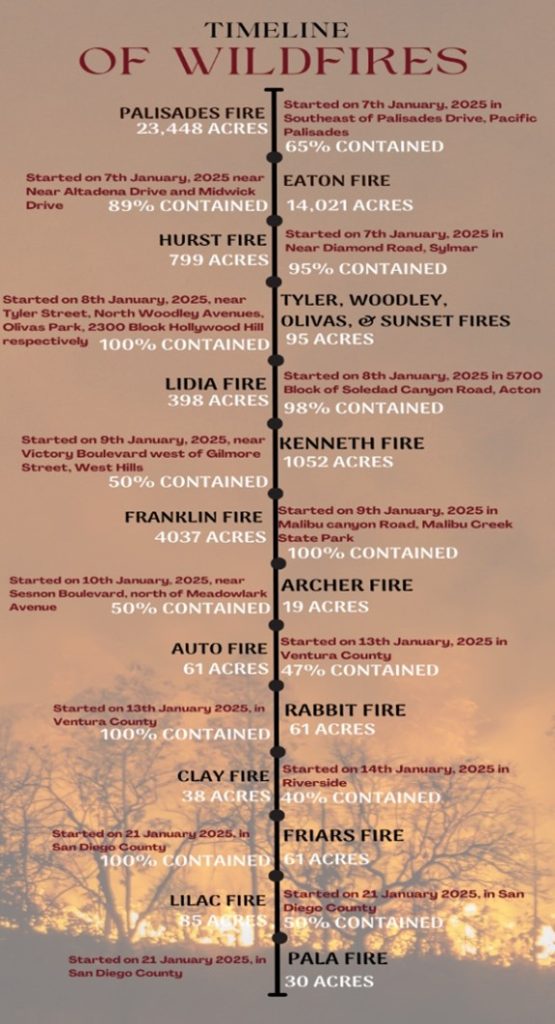
As of January 21, California is battling four active wildfires. The most significant fires include the Palisades Fire (23,713 acres), the Eaton Fire (14,021 acres), Lilac and Pala Fires. The Palisades and Eaton fires are now considered among the most destructive in California since records began in 1932.
This week, Intense high pressure over parts of the Great Basin will likely set up Santa Ana Winds over Southern California. Therefore, there is an extreme risk of fire due to weather over parts of Southern California. There are 20 to 40 mph winds, with stronger winds in the terrain and low relative humidity to prevail, as per the National Weather Service, NOAA[4].
RMSI Analysis and Findings
Rainfall Analysis
- The rainfall trend highlights considerable variability in precipitation, with some years showing extreme peaks and others experiencing significantly low rainfall.
- From 2012 till 2022, the precipitation in Downtown Los Angeles appears to show a below-average rainfall trend, followed by extremely heavy rainfall in 2022-2023. However, that flipped again to relatively dry conditions in 2024.
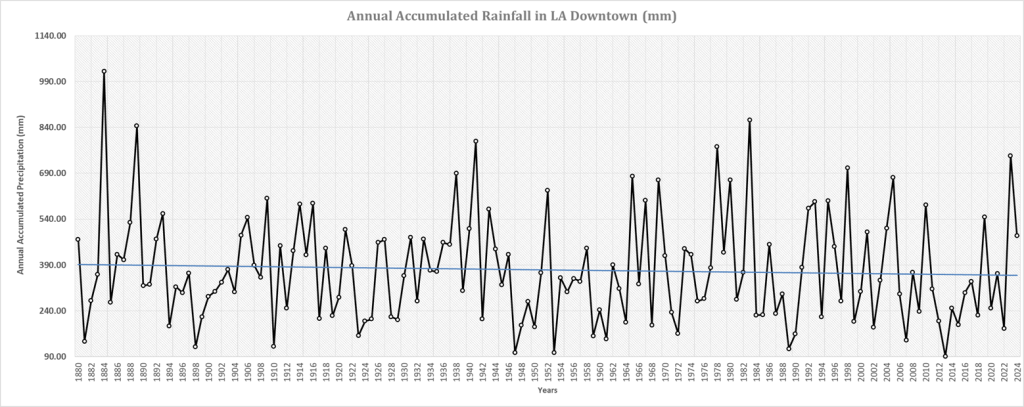
Temperature Analysis
- Figure 7 indicates a clear increasing trend in the mean annual temperature at LA Downtown from 1880 to 2024, consistent with global warming patterns.
- The last 20 years exhibit significant fluctuations but remain part of a broader warming trajectory. This trend is indicative of the impacts of urbanization and climate change.
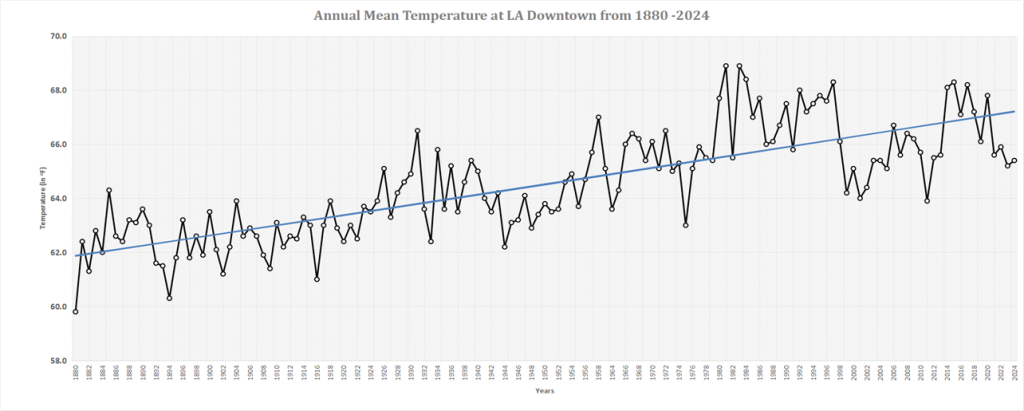
Damages to Buildings by Palisades and Eaton Fire
- Figure 8 indicates the spread of the Palisades fire from January 7 to January 11, 2025, across LA County.
- The spread of the Palisades fire is ~16.5km long and ~13km wide.
- The Palisades Fire covers about 35 square miles of area as of January 13, 2025, while New York City spans 302 square miles of land. This is roughly 12% of New York City’s total area.
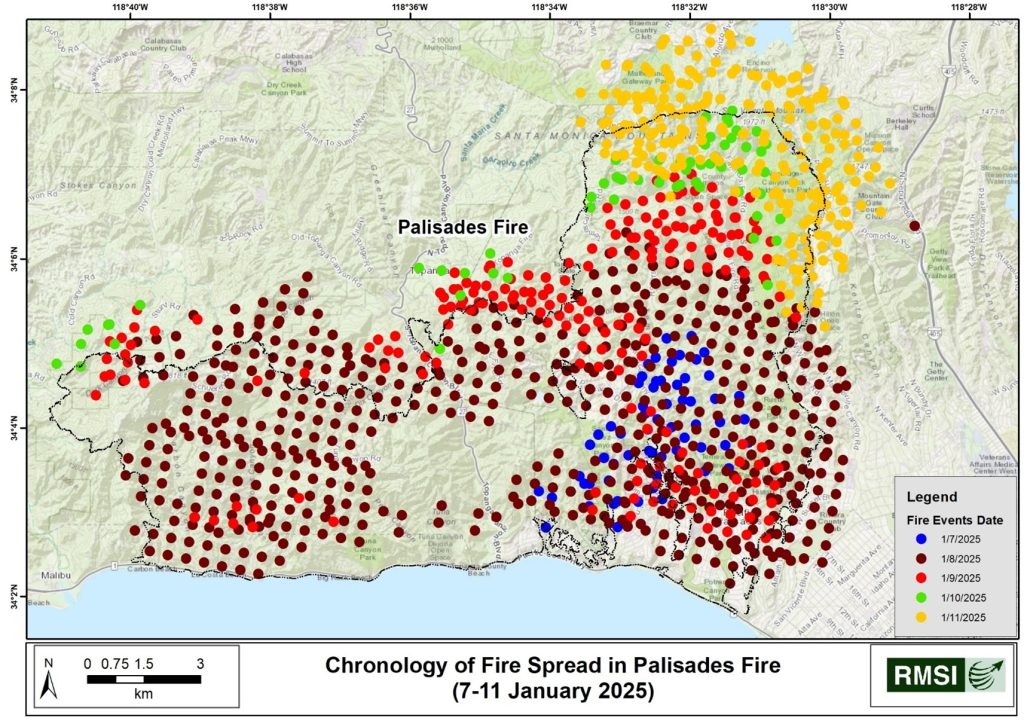
- Palisades active fire is burning between Santa Monica and Malibu.
- Palisades Fire destroyed more than 5000 structures, while the Eaton Fire damaged or destroyed more than 7,000 structures, as per aerial imagery.
- The counties most impacted by wildfires in 2025 are Los Angeles, Ventura, and Riverside County.
- About 60% of the buildings in Palisades and 45% in Eaton are already categorized as destroyed (>50%) due to the wildfire.
- Among the impacted buildings, 44% were in Palisades, and 54% in Eaton were Single-Family Residence Single Story buildings.
- The Majority of Single-family homes in the US were constructed using wood-frame, heavy timber, or modular construction, which significantly increased the spread of fire, leading to greater damage to this category of buildings.
- As of today, 65% of the Palisades and 89% of Eaton Fire have been contained from spreading.
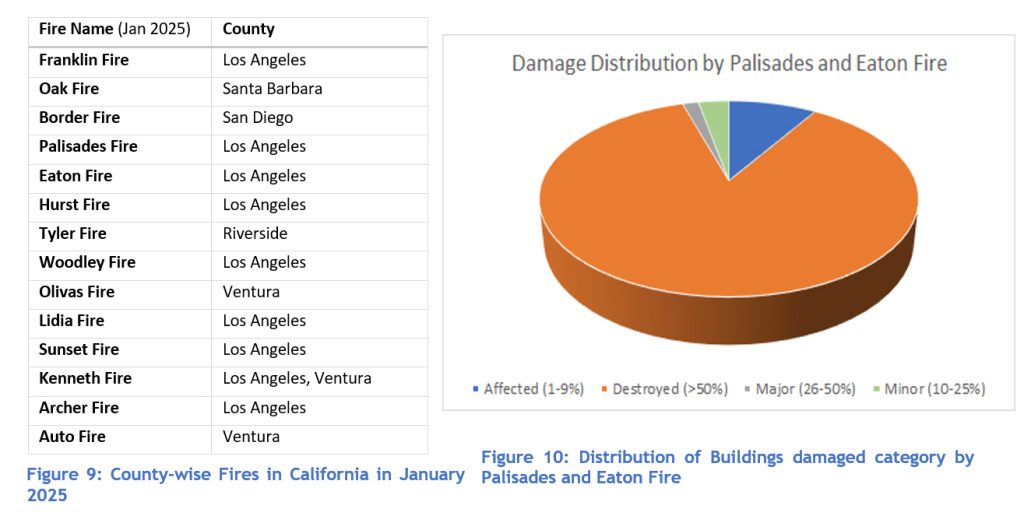
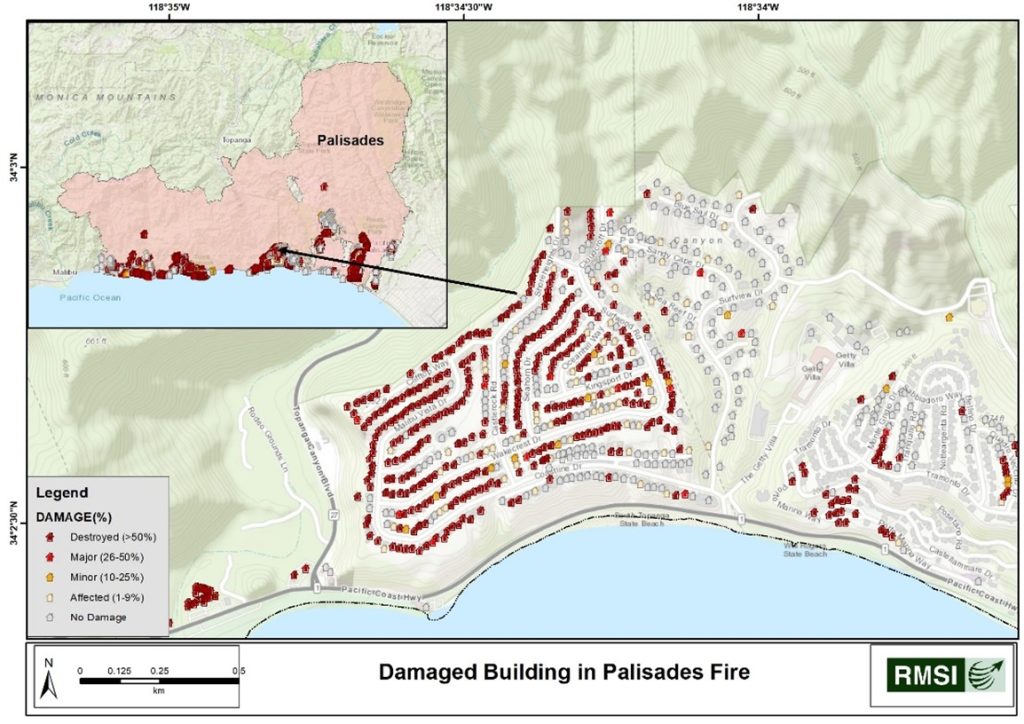
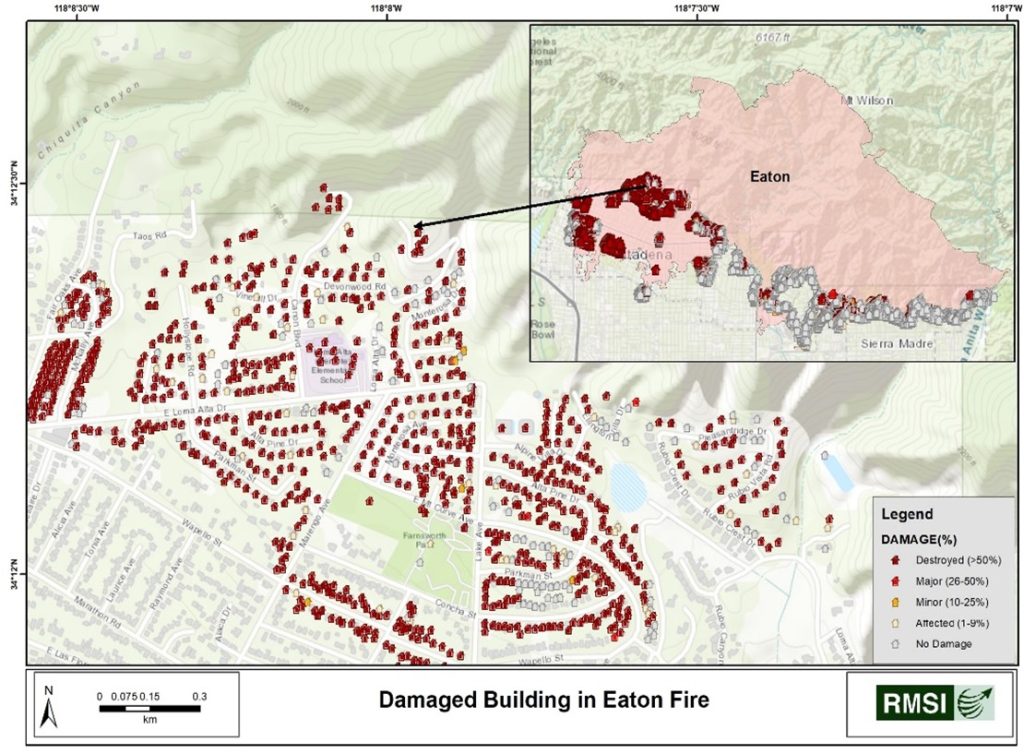
Impact on Insurance Giants
European companies are bracing for significant financial losses as California’s ongoing wildfires continue to wreak havoc, with damage exceeding $250 billion, as reported by Euronews. Reinsurance News says this catastrophe is poised to become the costliest blaze in US history, potentially leading to increased premiums and reduced coverage availability in high-risk areas. Analysts anticipate that the fires will be treated as a single event for reinsurance purposes, enabling primary insurers to access reinsurance coverage to mitigate losses.
- Among the hardest-hit reinsurers are Swiss Re, Munich Re, Hannover Re, and SCOR, with projected losses of €160 million, €220 million, €180 million, and €50 million, respectively[5].
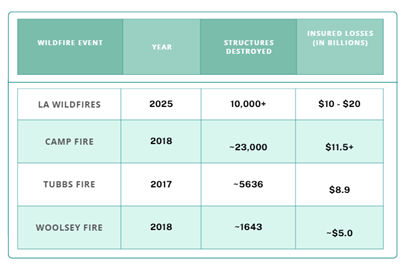
Way Forward
The impact of wildfires on Los Angeles is far-reaching. In addition to the immediate damage, there are long-term consequences for air quality, water resources, and the overall health of the ecosystem. The economic costs of wildfires can be substantial, with losses to property, businesses, and tourism.
In regions with high wildfire risk, like California, a critical step towards mitigation is to re-evaluate building practices. Historically, wooden structures were favored due to earthquake concerns. However, with advancements in construction technology, reinforced masonry structures can offer comparable safety and resilience against seismic activity.
Looking to countries like Japan, which experience frequent earthquakes but have a strong record of earthquake-resistant construction, provide a valuable model. Adopting similar building practices in wildfire-prone areas can significantly reduce the risk of fire damage.
Ultimately, mitigating the threat of wildfires requires a multi-faceted approach. This includes intelligent material choices and a proactive mindset across the community to develop and adapt early warning systems. Individuals, businesses, and policymakers must embrace the reality of the changing climate and take the necessary steps to adapt and prepare. By making informed decisions and implementing appropriate measures, we can reduce our vulnerability to wildfires and build more resilient communities.
[1] https://www.bbc.com/news/articles/c0ewe4p9128o
[2] https://ktla.com/news/california/how-la-nina-helped-fuel-devastating-southern-california-wildfires/
[3] https://time.com/7206942/los-angeles-wildfires-wind-science/?utm_source=chatgpt.com
[4] https://www.wpc.ncep.noaa.gov/discussions/hpcdiscussions.php?disc=pmdspd
[5] https://www.reinsurancene.ws/california-wildfires-unlikely-to-materially-affect-reinsurers-2025-earnings-berenberg/